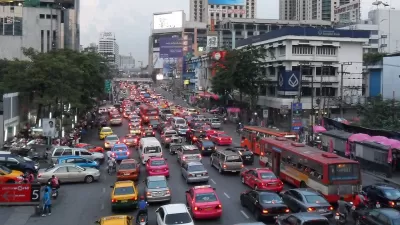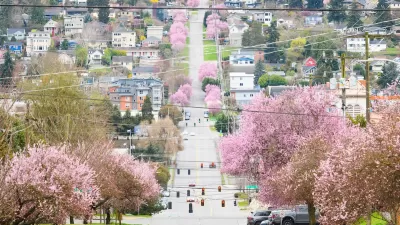Automobile-oriented planning requires that cities devote signifiant amounts of space to roads and parking—under many conditions each vehicle requires more land than is devoted to housing per capita.

Greetings from Colombo, Sri Lanka! Today is the last day of the Environmentally Sustainable Transport Forum in Asia, which is a major conference that explores ways to create more economically efficient, equitable and environnmentally-responsible transportation systems.

For this event I wrote a Backgounder (an overview document) titled, Implementing Transport Policies and Programmes toward Realizing “Bali Vision Three Zeros - Zero Congestion, Zero Pollution, and Zero Accidents Towards Next Generation Transport Systems in Asia” discussing the problems and solutions facing rapidly-developing Asian cities, which I presented yesterday (here is my slideshow). It is, of course, a great honor to have been invited to contribute to this event. It has been a very interesting and rewarding conference.
Asia is experiencing rapid economic development and urbanization. During the next three decades approximately 1.4 billion more people will live in Asian cities, which would require hundreds of new cities with between one and twenty million residents each. Ancient Rome took about five centuries to grow from 50,000 to one million residents, many Asian cities will do this in just three decades. The policies these cities establish now will lock in future transport and land use patterns for centuries. My researched examined which policies can minimize traffic congestion, accidents, and pollution as well as achieve other planning objectives. A key conclusion of this analysis is that policies which minimize automobile ownership and use tend to help create more efficient, safer, more equitable and environmentally responsible cities. This does not require eliminating private automobile travel altogether, but it does mean that everybody can benefit if public policies favor walking, cycling and public transport over automobile travel in the allocation of scarce resources, particularly urban land.
To put this into perspective I did a rough estimate of the amount of land required by each additional automobile. According to the FHWA's Highway Statistics report, large U.S. cities average 4.7 road-miles per 1,000 residents, or 25 road-feet per capita. Assuming 50-foot average road width, this is 1,240 square feet of road area per capita, or about 1,500 per motor vehicle. In addition, there are typically 2-6 off-street parking spaces per vehicle (see "Estimating Parking Lot Footprints In The Upper Great Lakes Region Of The USA," "Parking Spaces Outnumber Vehicle Owners 3-to-1" and “Parking Infrastructure: Energy, Emissions, And Automobile Life-Cycle Environmental Accounting”). Each parking space, including their driveways and access lanes, require, on average, about 300 square feet, or 600 to 2,400 square feet total.
Since each car requires road space plus two to six parking spaces (at home, work and other destinations), a car uses more land than most urban residents’ homes. Walking, cycling and public transit require far less space.
As a result, in automobile-dependent communities with road and parking supply sufficient to keep traffic congestion to the level typical in U.S. cities, plus parking spaces at most destinations, a city must devote between 2,000 and 4,000 square feet (200-400 square meters) of land to roads and off-street parking per automobile. This exceeds the amount of land devoted to housing per capita for moderate to high development densities (i.e., more than 10 residents per acre, which means less than about 4,000 square feet per capita), and is far more land than most urban neighborhoods devote to public parks. This illustrates the problems that growing cities face if they try to develop automobile-oriented transport systems where most residents own a private car: they will need to devote more land to roads and parking than to housing.
Automobile apologists could argue that vehicle land requirements can be reduced by using structured parking facilities and underground or overhead highways. Yes, that is possible but these strategies are very costly in their economic and environmental costs. For example, a typical structured parking space costs $30,000 to $60,000 to construct, so most structured parking spaces cost more than the vehicles that occupy them. Similarly, underground or overhead roadways typically cost more than $1 per additional peak-period vehicle-mile accommodated. As a result of these high costs, few travelers will use these facilities if they must pay cost-recovery fees to use them—most urban residents will only own a car and drive during peak periods if somebody else pays for their parking and roadway facilities. This is, by definition, economically inefficient.
In urban areas, a typical parking space has an annualized costs (combined annualized land value and construction costs, plus operating expenses) of $500 to $1,500, and more for structured parking. Assuming 2-6 parking spaces per vehicle, parking costs total $1,000 to $4,000 per urban automobile, compared with about $1,000 spent per vehicle by all levels of government on roads. This indicates that for every dollar spent on roads, one to four dollars is spent on parking facilities, a cost that is often overlooked in transport project evaluation, for example, when considering whether to improve public transit and support transit-oriented development, which reduces vehicle ownership and use, and therefore the number of parking spaces needed in a community.
There are many reasons that Asian cities should apply vehicle ownership and use reduction policies. Asian countries are committed to Zero Deaths, an agressive traffic safety target. They currently have high traffic fatality rates, between 20 and 35 traffic deaths per 100,000 residents. This should decline as they develop and implement more traffic safety programs, but the speed and degree death rates declines will depend on their transort and land use policies. With pro-automobile policies they can expect to end up with medium-level traffic fatality rates, 10-20 deaths per 100,000 residents, as in the U.S., but with transit-orientation and strong TDM strategies, they can reduce their traffic fatality rates by an order of magnitude, below 2 deaths per 100,000 residents, as in London, Tokyo and Stockholm.

A new study by Paul J. Burke and Shuhei Nishitateno, "Gasoline Prices and Road Fatalities: International Evidence," used two decades of data for 144 countries to calculate the the gasoline price elasticity of road fatalities. The results indicate that each 10 percent increase in gasoline pump prices reduces traffic fatalities 3-6 percent. It estimates that approximately 35,000 road deaths per year could be avoided by the removal of global fuel subsidies. Such subsidies are another example of harmful policies that must be corrected to achieve planning goals.
This is actually good news. It means that applying basic economic principles, such as efficient pricing of roads and parking facilities, urban planning practices that favor people over cars, and reduced fuel subsidies, are good for economic development, safety and health, as well as environmental quality.
There are many specific ways to reduce the amount of land devoted to roads and parking, as discussed in my report, Pavement Buster's Guide, including many strategies that help reduce total vehicle ownership, such as the city of Toyko's requirement that owners demonstrate that they have an off-street parking space before they are allowed to register a vehicle in the city. Since residential parking is mostly unbundled, this contronts motorists with the actual cost of a parking space, which helps explain that city's low vehilce ownership rate (for more information see Paul Barter's excellent report, Parking Policy In Asian Cities.
What do you think? How should scarce urban land be allocated? How can developing cities best control economically-excessive automobile ownership and use?

Alabama: Trump Terminates Settlements for Black Communities Harmed By Raw Sewage
Trump deemed the landmark civil rights agreement “illegal DEI and environmental justice policy.”

Planetizen Federal Action Tracker
A weekly monitor of how Trump’s orders and actions are impacting planners and planning in America.

Why Should We Subsidize Public Transportation?
Many public transit agencies face financial stress due to rising costs, declining fare revenue, and declining subsidies. Transit advocates must provide a strong business case for increasing public transit funding.

Understanding Road Diets
An explainer from Momentum highlights the advantages of reducing vehicle lanes in favor of more bike, transit, and pedestrian infrastructure.

New California Law Regulates Warehouse Pollution
A new law tightens building and emissions regulations for large distribution warehouses to mitigate air pollution and traffic in surrounding communities.

Phoenix Announces Opening Date for Light Rail Extension
The South Central extension will connect South Phoenix to downtown and other major hubs starting on June 7.
Urban Design for Planners 1: Software Tools
This six-course series explores essential urban design concepts using open source software and equips planners with the tools they need to participate fully in the urban design process.
Planning for Universal Design
Learn the tools for implementing Universal Design in planning regulations.
Caltrans
Smith Gee Studio
Institute for Housing and Urban Development Studies (IHS)
City of Grandview
Harvard GSD Executive Education
Toledo-Lucas County Plan Commissions
Salt Lake City
NYU Wagner Graduate School of Public Service
































